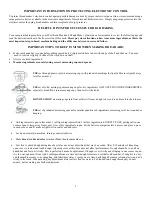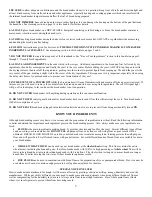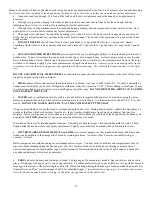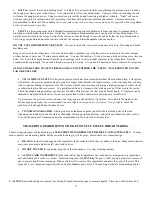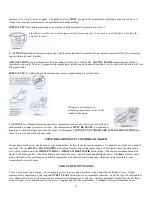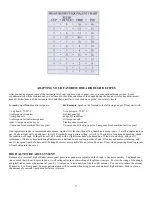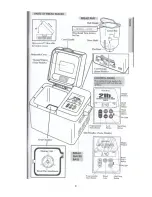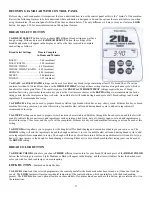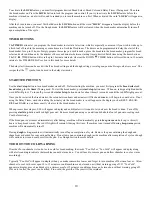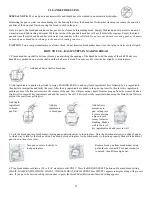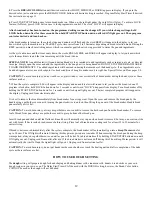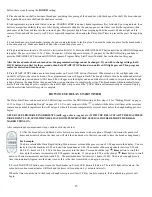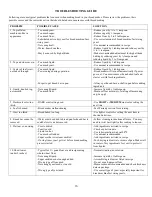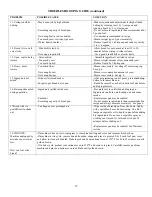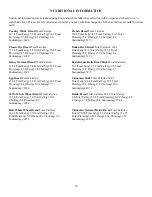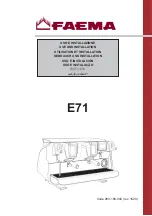
3
2 BE SURE
to allow adequate ventilation around the bread maker when it is in operation. Keep it out of drafts and direct sunlight and
at least 4 inches away from walls, cabinets and other appliances, especially heating and cooling appliances which can interfere with
the internal bread maker temperatures and affect the loaf of bread being prepared.
3.
DO NOT IMMERSE
base of bread pan in water or other liquid as this can damage the bearing on the bottom of the pan that turns
the knead bar. See cleaning section on page 14 in this booklet for further details.
4.
ALWAYS
place bread maker on a DRY, STABLE, heatproof countertop or table during use. Since the bread maker contains a
motor, some vibration occurs during the knead cycle.
5.
AVOID
touching bread maker during the bake cycle as exterior surfaces become hot. ALWAYS use potholders when removing
and handling the bread pan after baking.
6.
FOLLOW
instructions as given for best results.
THE MOST IMPORTANT STEP IN BREAD MAKING IS TO MEASURE
INGREDIENTS ACCURATELY
. See measuring section in this booklet on pages 5 and 6.
7.
DO NOT EXCEED
the ingredient capacity of the bread maker. See “Know Your Ingredients” section in this booklet on pages 3
through 5. Use only fresh ingredients.
8.
ALWAYS ADD INGREDIENTS
in the order listed in the recipes. Add liquid ingredients to the bread pan first, followed by dry
ingredients, then butter or margarine and finally the yeast in the very center. Before adding the yeast, ALWAYS tap the pan to settle
the dry ingredients, then level off the ingredients, pushing into the corners to prevent liquid from seeping up. Then add the yeast to the
very center of the pan, making a slight well in the center of the dry ingredients. This sequence is very important, especially when using
the delay start timer of your bread maker to prevent over fermentation of the yeast.
9
.
IN THE EVENT OF A POWER OUTAGE
, the bread maker will turn off automatically and remain off when power is restored. If
this occurs, you will need to remove the contents from the bread pan and start over using fresh ingredients. The red ON signal light
will go off in the display to let you know the bread maker is not in operation.
10.
DO NOT COVER
bread maker with anything during operation as this can cause malfunction.
11.
DO NOT TOUCH
control panel buttons after bread maker has been turned ON as this will interrupt the cycle. Turn bread maker
OFF after completion of cycle.
12.
DO NOT LEAVE
bread make plugged into electrical outlet when not in use to prevent it from being accidentally turned
ON
.
KNOW YOUR INGREDIENTS
Although bread making seems very basic, it is a science and the proportions of ingredients are critical. Read the following information
to better understand the importance each ingredient plays in the bread making process. Also, always make sure your ingredients are
fresh.
•
FLOUR
is the main ingredient in making bread. It provides structure and food for the yeast. Several different types of flour
can be used in your bread maker, but
DO NOT USE
all-purpose flour, cake flour or self-rising flour as poor results will be
obtained. BREAD FLOUR SHOULD be used in your bread maker as it contains more gluten-forming proteins than all-purpose
flour and will provide tall, well formed loaves with good structure. Several different brands of bread flour are available for use in
your bread maker.
•
WHOLE WHEAT FLOUR
can be used in your bread maker at the
whole wheat
setting. This flour contains the entire
wheat kernel, including the bran and germ; therefore, breads made with 100% or a high percentage of
whole wheat
flour will be
lower in height and heavier in texture than bread made with bread flour. The whole wheat setting on your machine has a longer
knead time to better develop the structure of wheat breads for optimum results.
•
RYE FLOUR
can be used in combination with bread flour in the preparation of rye or pumpernickel bread. But, it cannot be
used alone as it does not contain enough protein to develop adequate gluten for structure.
SPECIAL NOTE ON FLOUR
How to make minor adjustments for dough: All flours are affected by growing conditions, milling, storage, humidity and even the
manufacturer. While not visibly different, you may need to make some minor adjustments when using different brands of flour as
well as compensating for the humidity in your area. Always store flour in an airtight container. Store whole grain flours (whole
wheat, rye) in refrigerator to prevent them from becoming rancid.
Summary of Contents for L4972T
Page 9: ...8...


